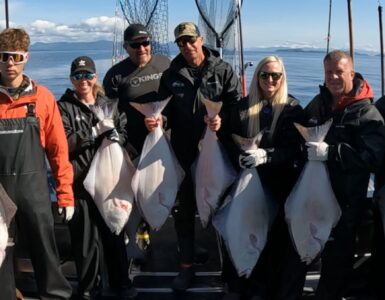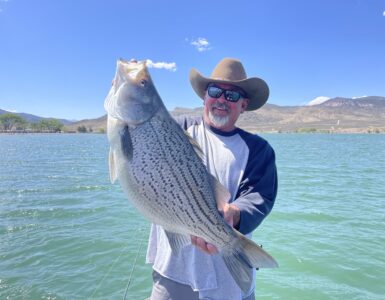(Intro Adam Eakle, Tonya Kieffer) thanks for tuning into KSL Outdoors, I’m Adam Eakle. (tonya) and I’m Tonya Kieffer. (adam) it was two months ago we were here at Flaming Gorge and we were fishing with Ashley Bonzer right there. (tonya) and as you see somebody paid attention because everybody right there fishing. (adam) there is a lot of people, the 2013 Burbot Bash is underway and over a thousand people are braving the elements and out here trying to catch some fish and some big bucks.
(nats wheeler) see you guys. Good luck.
Nearly twelve hundred anglers ventured out on four wheelers, snowmobiles, even trucks for the 3rd annual Burbot Bash. Every point looked like a small town has gathered on the ice.
(Keith Murphy, Payson Burbot Angler) Oh way to many people. (laughs)
(Kyle Jeffries, Hooper Burbot Angler) Last year there as hardly anybody, but this year has just been crazy.
(Kyle Jeffries) That just means a lot more money for the economy around here which I’m sure everyone is happy about so. We are spending our share of money.
The Flaming Gorge Chamber of Commerce organizes the Burbot Bash to increase the exploitation of this invasive species and to give the local economy a boost during their slow season. The Utah DWR and Wyoming Game and Fish are also involved. Over the years they’ve inserted these pit tags into hundreds of burbot. If the fish is caught during the bash, the angler receives a cash prize. This year an additional 25 burbot were tagged with external tags that if caught could net the angler ten thousand dollars. More importantly however is the biological data biologists generate from the returned tags. It helps them better understand the burbot population in Flaming Gorge.
Utah State University scientists, in a study funded by the Utah DWR are also conducting research on the burbot.
(Carl Saunders, USU Post Doctorate Research Scientist) October, November we came out here and used trammel nets to collect burbot, got live burbot and put acoustic telemetry tags in burbot that were larger than about 30 inches. Released those fish and now in January we are back tracking those with telemetry ears. It’s similar to radio telemetry which wildlife biologists use to track elk.
The scientists implanted 31 telemetry tags into burbot. Using a hydrophone that they stick under the ice, they are able to track the movement of the fish. What they are finding is stunning these researchers. Some of the burbot have traveled nearly 40 miles.
(Ryan Mosley) We hope to learn where these burbot are moving in the reservoir, where they are going, where they want to spawn. When we can identify those areas if there is mass concentrations of burbot spawning in key locations. We’d like to direct angler pressure to those locations. Harvest them, get them out of the reservoir. Also potentially doing some treatments.
(Adam) did you get him? (darrell) oh yeah. (adam) nice.
In three years Burbot Bash anglers have taken out over ten thousand fish. Biologists aren’t sure how much impact anglers are having on the population. But you would have to figure they are making a dent.
Last year at the Burbot Bash, team Meeks caught the second most burbot. This year, in just one evening they’ve already put 123 on ice. The team with the most burbot after the two day tournament wins a substantial amount of money. Most aren’t doing as well as the Meeks.
(Dennis Mcgraw,1st time burbot angler) but you know what we are here for the experience, it doesn’t matter what we come away from. Having a ton of fun with my boy, a lot of good food and conversation with local fisherman.
(Darrell Meeks, Green River, Wyoming angler) Yeah you get a lot of people out here, lot of commotion on the ice, four wheelers, augers running and people jammed together, the fish kind of shut down a little bit I think.
Hundreds were on hand to check in their catch at the close of the bash. In two nights anglers had caught over four thousand fish.
(nats of reader) (craig) there’s the tag number.
and turned in nine internal pit tags dating back to November 2010. Every tag returned, netted the angler $300.00.
(Carl Saunders, USU) this was a rainbow trout, about a 15 inch rainbow trout came out of about a 33 inch burbot.
USU scientist were also there collecting data and Carl made an interesting observation. He thought anglers would have a better impact on the burbot, if they learned to catch them before they spawned.
(Carl Saunders) Many of them have already spawned which means that a fish that is 20 inches can have 500,000 eggs that they’ve already laid. 49:21 The early that we can get to these fish, especially if we can get to them before they spawn, the more of a dent we are going to have in the population. 49:27 so open water in a boat is a really good way to remove large females that are going to contribute a lot to the population.
At the closing ceremony, they had the usual burbot fish fry to give everyone a chance at tasting a burbot and the always popular filleting contest.
(Craig Collett, Flaming Gore Chamber President) This is fantastic, I tell you we never anticipated this kind of turnout.
(Craig) because of that we are going to give away a lot more money than we anticipated.
The pay-outs were huge. In the youth division, 5th place to 1st place got some cash for the smallest and biggest burbot. For the adults…
(Adam on mic) biggest burbot caught for 5K team 517 Reese.
(Team Reese) it was a team effort man we are going to split it.
and with a total of 211 fish, team Meeks took home five thousand dollars as well.
(Adam) you guys better be back next year to defend your title.
(Adam intro) Welcome back to KSL Outdoors and Flaming Gorge Reservoir, I’m Adam Eakle. Well now that you’ve seen people out enjoying the annual Burbot Bash, you might think to yourself if you’ve never done it, man that looks fun but it looks pretty cold, at night on a reservoir. Yeah it can be, but don’t forget there’s other species up here at Flaming Gorge, there’s a great rainbow trout fishery as well as some lake trout.
(Roger) He’s coming up to my jig.
(roger hit) there he is (roger) a swing and it’s a long drive to center field.
Roger Schneidervin was the fisheries biologist at Flaming Gorge for over two decades. After all those years he still enjoys mixing it up with current biologists and fishing for small lake trout.
(roger) A home run! (laughs)
(Roger Schneidervin, Retired DWR Biologist) When these lake trout pups are small and eating plankton and creyfish, they get a real orange flesh. They are especially good to grill them and they also take smoke real well. Smoking or grilling them they are excellent. Totally different animal than when they get 28 inches long and start feeding on fish.
The lake trout fishery at Flaming Gorge is no doubt one of the best in the lower 48. The limit is 8 fish with one over 28 inches. Most anglers however, release lake trout over 28 inches to allow others the chance to catch these giant macks.
(Craig Amadio, Wyoming Game and Fish Fisheries Biologist) So we are trying to conserve the larger component of the population but still encourage harvest of the smaller lake trout. We still have a lot of the smaller lake trout and need to keep those numbers in check so that we don’t all of a sudden see an explosion of the lake trout numbers that will have really negative consequences with the kokanee and the rainbow and the other sport fish we are trying to manage for.
(Ryan) got a good one? (adam) feels like a pretty good one. Finally!
(fish at hole) (adam) nothing wrong with him! (gets off) (ryan) get him grab him! (laughs)
(Ryan Mosley, DWR Flaming Gorge Project Leader) I’m using some hardware and getting hits. Caught a couple, buckshot spoon, rapala jigging raps even these rapala jigging shad raps have been pretty effective, just tipping them with sucker meat.
(Ryan) we are just trying to keep the balance in the reservoir of predator and prey, keep our kokanee densities up. Of course kokanee are our primary forage for lake trout so. It seems to be working really well. We were at all time lows for kokanee in 2007 and 08 and then we had an all time high in 2009 and 2010 so. It’s been showing some promise, We are seeing high densities of kokanee again and healthy lake trout, it’s been fantastic.
Let’s head back to Salt Lake for some more fishing tips with the guys at Fish Tech.
(Fish gets off) (laughs) (roger) hey we are making a habit out of this!







Add comment